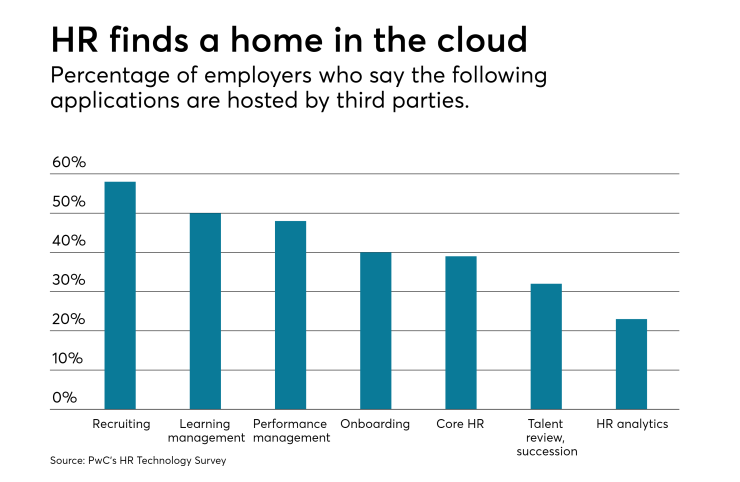Once the domain of science fiction films and novels, artificial intelligence has moved beyond the realm of the fantastic into everyday life. AI is impacting virtually every area of our lives – from how we perform daily tasks at home and work to how we access entertainment and purchase goods and services. Ever ask Alexa for today’s weather forecast or last night’s baseball scores? Control your home or office climate via app? Those are all examples of artificial intelligence making our lives better.
In the workplace, AI has firmly taken root, as people come to realize their fears of being replaced by machines are largely overblown. While mentions of artificial intelligence tend to conjure up visions of assembly lines populated by an assortment of robotic arms, organizations are employing the transformative power of AI throughout the workplace – from performing repetitive tasks to analyzing data to facilitating and enhancing video conferences.
Increasingly, AI is being employed in the HR realm to drive employee engagement and retention, recruitment and experience, diversity and inclusion, and ultimately, performance and efficiency.

Nearly 40% of companies are using some form of AI within the HR function, according to research from Bersin by Deloitte. To date, HR applications of AI have been most prevalent in the hiring process.
They are improving and streamlining the hiring process by eliminating biased and gendered language in job listings, assessing applicant responses to screening questions, scheduling follow-up interviews, providing analytics for candidate assessment, and even sending thoughtful, automated responses to a candidate post-interview.
Increasingly, organizations are leveraging solutions that incorporate machine learning, natural language processing and sentiment analysis for even more complex applications. In doing so, they are revolutionizing the HR function, while freeing up and empowering HR staff to focus on more strategic initiatives. AI’s deep analytics capabilities, for example, are allowing talent leaders to understand the risks and financial impacts of attrition, enabling them to take mitigating action. Meanwhile, data visualization tools, such as heat maps and word clouds, are measuring tendencies toward discrimination and prejudice, politics and hierarchy and other concerns in an inclusive and diverse workforce.
As organizations move away from traditional annual performance reviews in favor of ongoing, real-time appraisals, AI and machine learning tools are being employed to identify who an individual works with most frequently, solicit feedback and then make suitable recommendations for training and development. Perhaps most remarkably, sentiment analysis can identify changes in someone’s spoken or written words or tone to suggest when they might be thinking about leaving the organization, giving HR the opportunity to intervene while there’s still the possibility of retaining a valued employee.
Increasingly, organizations are rolling out new self-service systems that rely on chatbots and virtual assistants to engage employees. They leverage AI and natural language processing to simulate the experience of interacting with a real person to deliver immediate, personalized guidance and support on a broad range of HR and benefits-related questions.
Alight’s intelligent virtual assistant, Lisa, answered more than 2 million questions in her first year alone, serving as a high-touch resource on topics like annual enrollment, health savings accounts, password issues, and medical and retirement benefits. The 24/7 availability of such resources enables employees to reach out whenever and wherever they find most convenient. In Lisa’s case, nearly one-third of conversations take place outside of normal business hours.
AI is also being employed to tackle employee health needs through instant access to care and personalized care management. Chatbots, like Lark, part of the Alight Partner Network, leverage AI to create data-driven, personalized interventions to drive behavior change in chronic disease management and prevention. This enables organizations to not only drive down their costs, but also provide a more engaging, intimate, personalized and rewarding experience to their employees.
Getting HR to embrace AI is a journey. While studies have found organizations overwhelmingly recognize AI’s potential to revolutionize and improve the employee experience, many HR execs are hesitant to adopt it, as concerns abound about taking the “human” out of human resources. Clearly, that is not the case. When the more process-driven tasks get automated, it will enable HR to morph into an organization that provides high-touch, individualized attention, rather than having to manage people assets – thus putting the "human" back into human resources.
When it comes to incorporating AI into HR processes, we’ve just begun to skim the surface. As AI systems continue to evolve, get smarter, and are more proven, their uses will become more ubiquitous. Not only will AI transform the HR tasks for recruitment, talent management, employee engagement, but it will drive benefits management, lowering costs for the employer, while dramatically driving the productivity, efficiency, performance and well-being of the employee.





